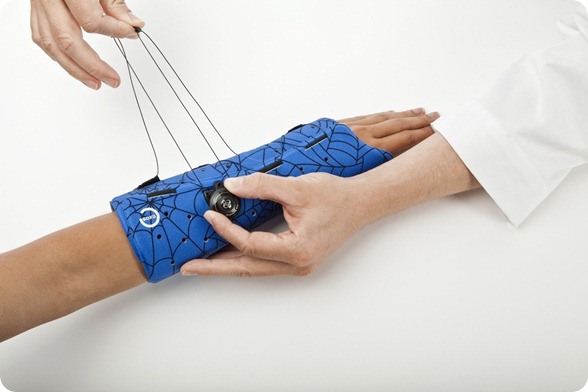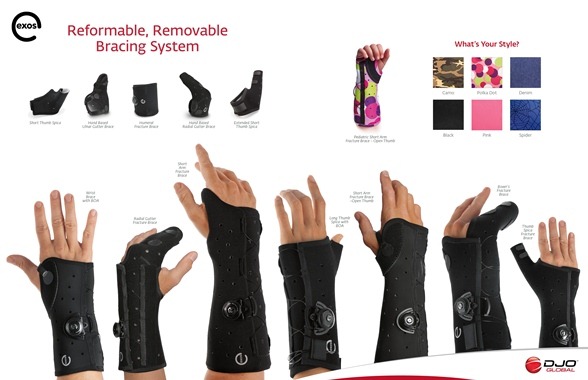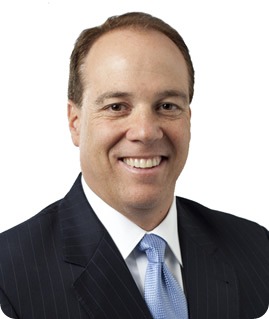Surprisingly, there are significantly more medical treatment episodes for upper extremity fractures than for those of lower extremity. The vast majority of forearm, hand and wrist fractures occur in pediatrics and young adults as they tend to be more active and involved in sporting activities.
Depending on the severity or displacement of the injury, fractures are typically stabilized via surgical procedures and or with a traditional fiberglass or plaster cast. Stabilization of these injuries allows the bones to heal in proper alignment and reduces the risk of any functional or range of motion loss. Fiberglass and plaster casts have been around for decades, and now DJO Global has got something really exciting and new with Exos.
What are the main problems with the current treatments for fractures?
Although fiberglass and plaster casts are effective and have been the standard of care for a long time, they do have some shortcomings. Casts are static devices that cannot adjust to changes in limb volume due to swelling or disuse atrophy and the difficulty they cause in maintaining hygiene is a big issue for patients.
Casts are often replaced during the course of treatment, which takes patient and clinician time and requires a cast saw for removal. While the cast saw can be unnerving for adults, it can be even more traumatic for children. Comfort, skin issues, and being unable to view the patient’s skin and injury site are also of concern.
How does the new bracing system from DJO Global overcome these problems and do you think that traditional casting could be completely replaced by your product?
Traditional casting will always have its place as more severe or displaced fractures do require a traditional cast to reduce or realign the fractured bones properly. Exos is intended to be used alongside traditional casting as either a step-down from a cast after some healing has occurred in the aforementioned type of fracture, or as a primary treatment when the injury is less severe or non-displaced.

Exos braces are removable, adjustable, re-formable and waterproof, and address many of the shortcomings of traditional casting. All Exos braces are warmed and custom formed directly on the patient for the best possible fit and comfort and many utilize the Boa® Closure System which allows them to be adjustable and removable. This adjustability and accommodation of atrophy or swelling is a big benefit as is the ability to remove the device without a cast saw. In addition, easy removal allows the clinician to view the skin and injury site and there is the potential to begin rehab or physical therapy earlier.
The waterproof aspect and ease of maintaining hygiene is probably the biggest benefit for patients. We often hear from patients who thank us for their Exos brace because they had a cast before and with Exos, they can now wash their skin and brace. It may sound trivial, but having the ability to easily maintain hygiene is a huge benefit when patients are in a device for that long.
A perfect example is a child with a stable forearm or wrist fracture. A stable fracture like this would typically be placed in a cast to protect the child from exacerbating the injury, and they’re in that cast for weeks. The Exos pediatric fracture brace has a locking ring and key for the Boa® that allows the brace to be locked in place during the day and allows the parents to remove the brace to wash the skin and brace any time. The colors and patterns available are a hit with the kids too.
What other benefits are there of the Exos products?
Exos is re-formable, so if the initial position to treat the fracture is incorrect or needs to be changed over time, it’s just reheated and reformed. A cast would require removal with a saw, throwing away the old cast, and reapplying a new one, not to mention all of the mess involved.
All Exos braces are treated with an anti-microbial that can reduce bacterial proliferation and odor. In addition, they go on warm and patients love the feel of the warmth and compression.
While the patient experience is dramatically improved, so is the experience for the clinician. Exos braces take less time to apply and remove, reduce stress by avoiding the cast saw, allow one device to be used throughout the continuum of care, and can help to differentiate and market the doctor’s practice by word of mouth.
Please could you outline the range of different Exos products?
There are currently 15 different Exos braces with a number of new products in development. The current range includes hand based devices for finger and hand injuries, forearm based devices for hand, wrist and forearm injuries, a humeral fracture brace, and a line of pediatric wrist and forearm fracture braces.

Many of the braces are available in six attractive patterns that go over as well with adult patients as they do with children.
Are the Exos products changing how upper extremity orthopedic surgeons are casting injuries?
Exos is DJO Global’s fastest growing product line. It offers a far better patient experience and a superior experience for the clinician so the adoption curve has been greatly accelerated. Over 390,000 Exos braces have been applied since their introduction in 2009.
20 years ago, lower extremity injured patients would go into a cast, but today they go in a walking brace/boot because it’s an all around better approach. Exos is just like the walking brace of 20 years ago, but for upper extremity.
What plans do DJO Global’s Bracing and Supports division have for the future?
We will certainly be exploring opportunities to do more with Exos given the tremendous success we have had with clinicians and patients utilizing today’s existing platform of products. The revolutionary technology provides us with ample grounds to continue to expand our line of upper extremity products while investigating designs to help treat or prevent injuries to other areas of the body.
Where can readers find more information?
To learn more about Exos, please visit our website at:
www.djoglobal.com/our-brands/exos
Or call DJO Global Customer Service at:
800-336-6569
[email protected]
About Steve Ingel
 Steve Ingel is President for the Bracing & Supports Division of DJO Global, responsible for managing the collective brands of DonJoy, Aircast, Procare, & Exos.
Steve Ingel is President for the Bracing & Supports Division of DJO Global, responsible for managing the collective brands of DonJoy, Aircast, Procare, & Exos.
He has so far had an eighteen year tenure with DJO, which has included many commercial management and national contracting roles both domestically. (Regional Sales Manager ProCare, National Sales Manager Procare, VP of Sales AC/PC & Corporate National Accounts, SVP/GM Bracing & Supports and National Accounts, SVP Sales Orthopedic Specialties, SVP Sales & Marketing B&S).
Prior to DJO he owned and managed a medical device distribution business for 9 years, located in Los Angeles County primarily focused in the orthopedic rehabilitation and instrumentation space.
Steve has Bachelor of Science Degrees in Finance & Marketing with a minor in Economics from California State University, Northridge.
He is an avid athlete and played four years of college tennis.
Steve currently resides in Carlsbad, California with his wife Tracy and three children Ashley, Tyler, and Michael.